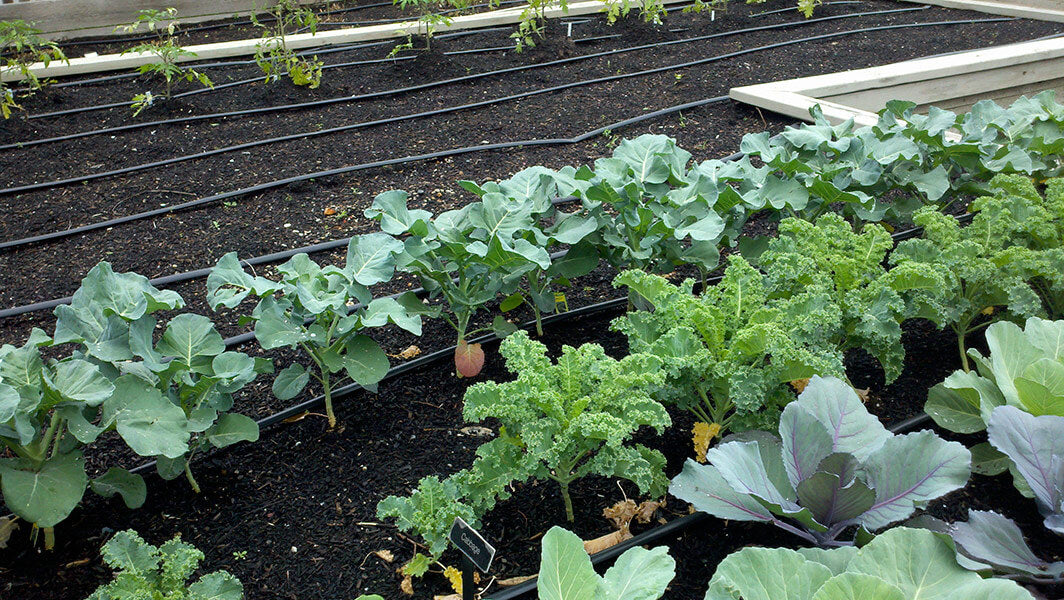Broccoli is a hardy vegetable that develops best during cool seasons of the year. Two crops per year (spring and fall) are possible in most parts of the country, especially with continuous improvement in fast maturity and heat tolerance that extends the life of broccoli through all but the hottest parts of the season. It belongs to the cole crop family (Brassica oleracea), which includes cabbage, Brussels sprouts, cauliflower, collards, kale, and kohlrabi.
Quick Guide to Growing Broccoli
- Plant broccoli during the cool weather of early spring and fall. Grow it in containers or an in-ground garden.
- Space broccoli plants according to the label (usually 18 inches apart). Choose a location with full sun, easy access to water, and fertile soil with a pH between 6.0 and 7.0 (amend soil with lime if necessary).
- Before planting, improve native soil by working in several inches of compost or other rich organic material.
- Keep soil moist by giving broccoli plants 1 to 1.5 inches of water per week.
- Make the most of your broccoli growing efforts by regularly feeding with a continuous-release plant food.
- Lay down a thick layer of organic mulch made from finely ground leaves or bark to preserve soil moisture and prevent weeds.
- Timing and temperature are critical for successful growth. The ideal growing temperature range is 65 to 80° F.
- Harvest broccoli when the center crown is full of tiny, green, tightly-packed buds.
Soil, Planting, and Care
Broccoli needs cool weather, full sun, water, and rich soil. For best success, start with young, vigorous Bonnie Plants® broccoli plants, which will put you significantly closer to harvest than if you were to start from seeds. Plant your broccoli where it will get least 6 hours of sun daily and has fertile, well-drained, moist soil with plenty of organic matter. Mulch will help keep the ground cool and moist. The soil pH should be between 6.0 and 7.0 for best growth and to discourage clubroot disease. To be sure about your soil pH, it is best to get the soil tested. You can buy a kit or have a soil test done through your regional Cooperative Extension office. Adjust the pH with lime, if needed, according to the test results.
For optimum growth in your garden, it's important to use a combination of premium-quality soil and plant food to support your plants. Make big improvements your soil by mixing aged compost-enriched Miracle-Gro® Performance Organics® All Purpose In-Ground Soil in with the top few inches of native soil. If you're growing broccoli in a container, be sure to choose a pot that is at least 18 inches in diameter (measured across the top) and fill it with Miracle-Gro® Performance Organics® All Purpose Container Mix (also enriched with compost) to provide plant roots with just the right environment. Wherever you choose to plant broccoli, you'll also want to feed regularly with a continuous-release fertilizer like Miracle-Gro® Performance Organics® Edibles Plant Nutrition Granules, according to label directions.
Plant at the spacing stated on the Bonnie label. Generally, broccoli plants should be 18 inches apart. If planted in rows, space rows 24 inches apart to give yourself enough room to walk between them, but you can plant two or three abreast in a row to minimize aisle space.
Broccoli likes steady moisture to grow fast and produce good heads, so water regularly, applying 1 to 1.5 inches of water per week if rain doesn't cover it. You can measure the amount of water with a rain gauge left in the garden. An organic mulch of compost, finely ground leaves, or finely ground bark will help keep the soil cool and moist and keep down weeds. In cold climates, it's the opposite, you may need to plant through black plastic in early spring to help warm the soil or leave the ground without mulch so that the sun can warm it.
Troubleshooting
Broccoli is temperature sensitive. If transplants sit exposed to cold below 40 degrees for a week or two, the chilling injury triggers heads to form way too early. On the other end of the scale, if you plant too late and the weather gets hot, you'll get the same early blooming, so plant your broccoli on time. The ideal temperature for broccoli is between 65 and 80 degrees. For local planting dates, check with your local Cooperative Extension office.
The best way to avoid pest problems is to keep your plants healthy and your garden clean. The main insect pests include cabbage loopers and imported cabbageworms, cabbage root maggots, aphids, and flea beetles. Disease problems include black leg, black rot, clubroot, and yellows. Contact your regional Cooperative Extension office for more information on pest identification and current control recommendations.
Harvest and Storage
When you see a flower head beginning to form in the center of the plant, check its growth every day. Ideally, you harvest broccoli while the tiny buds are tightly closed. If the buds begin to swell or show yellow (the flower petals), cut the head from the stem right away, no matter how small it is, because the opening buds have a mealy texture. After cutting the main head, leave the plant to grow bite-sized side shoots in the axils of the leaves.
Don't be disappointed if your broccoli head is smaller that those in the grocery store; they are usually grown in a friendly climate and with lots of pampering. In areas where spring heats up fast, broccoli heads are often better in fall than in spring, so try again for a bigger head later. Plant in late summer. Heads keep for about a week in the fridge.




FAQs
Can broccoli be grown in the spring and the fall?
Generally, yes, depending upon the variety, the region, and the time planted. Broccoli does best when temperatures remain between 40 degrees and 70 degrees F. It needs to mature during cool periods, so it does well in most areas if planted in late summer to mature in fall. In spring, broccoli is planted early enough to mature during cool weather. Temperatures below 25 degrees F can damage or kill broccoli.
How will I know when my broccoli is ready to harvest?
Generally, you should harvest broccoli when individual buds of the broccoli head are pin-head size, dark green, and tightly closed. If yellow petals begin showing, the head is past its peak quality. After growing a certain variety for several seasons, you will soon know the potential size for heads of that variety. The size of the head depends on location, variety, season, and fertilization. Most homegrown heads are three to six inches in diameter.
Can I grow broccoli in a container?.
Yes, use a container 5 gallons or larger, or at least 18 inches in diameter
After you plant broccoli, do you have to top the plants?
No, that would remove the central head and you won't get the harvest that you expect. However, you would get small side shoots.
My broccoli foliage is developing yellow spots on the upper side with a downy growth underneath. What does this mean?
This is downy mildew, a disease caused by an airborne fungus. Some varieties of broccoli are resistant to this. Foliar sprays of chlorothalonil (Daconil¨) can be used to control this problem. Begin applications at the first sign of the disease and repeat according to label directions.
How can I control worms that get in my broccoli heads?
These are probably loopers or imported cabbageworms that can be controlled with a product containing Bacillus thuringiensis (Bt) such as Dipel¨, a biological-type insecticide. This must be eaten by the worm and is activated in the worm's alkaline gut. The worm then dies slowly from terminal constipation. This takes two to three days, which means the worms are not killed immediately.
My broccoli produced small yellow flowers shortly after I planted it and the heads were tiny. What caused this?
Hot weather is the culprit. The plant is going to seed. Broccoli flowers quickly in temperatures much above 80 degrees. Be sure that you are planting at the right time. Next time, you should cut off the broccoli heads before they form flowers, no matter how small they are.
What causes broccoli heads to become discolored and slightly slimy?
Under certain environmental conditions, such as high temperatures during the initiation of the head, discoloration occurs. This has been observed on some of the hybrid varieties. Planting at the correct time and providing good cultural care usually avoids the problem.
On some of my plants, the stem has a hole that retains water and causes rotting after I remove the main head. What can I do?.
The hole in the stem cannot be corrected now. It is caused by a boron deficiency that is corrected by adding boron to the soil for next year. The rate is one-half pound per 1,000 square feet of a boron product such as Twenty Mule Team Borax. Dissolve it in two gallons of water and spray it evenly over the ground. DO NOT OVER APPLY. Boron toxicity occurs if too much is added, so use only what is required. Don't be tempted to think that a little extra is better
Is it normal for seconday sprouts to be smaller or should we fertilize?
The center head produced by broccoli is always the largest. The secondary heads are about the size of a silver dollar. Side-dressing with fertilizer can increase yields and size of these shoots. Although small, they are just as tasty as the large center head.
A few of my broccoli plants did not produce heads, but look healthy. What is wrong?
If the growing tip of a broccoli plant is injured, it may not head. This is called blindness. The transplant could have been injured in transit, while planting, or by an insect in the garden.




 Herbs
Herbs
 Vegetables
Vegetables
 Fruit
Fruit
 Flowers
Flowers
 Succulents
Succulents


